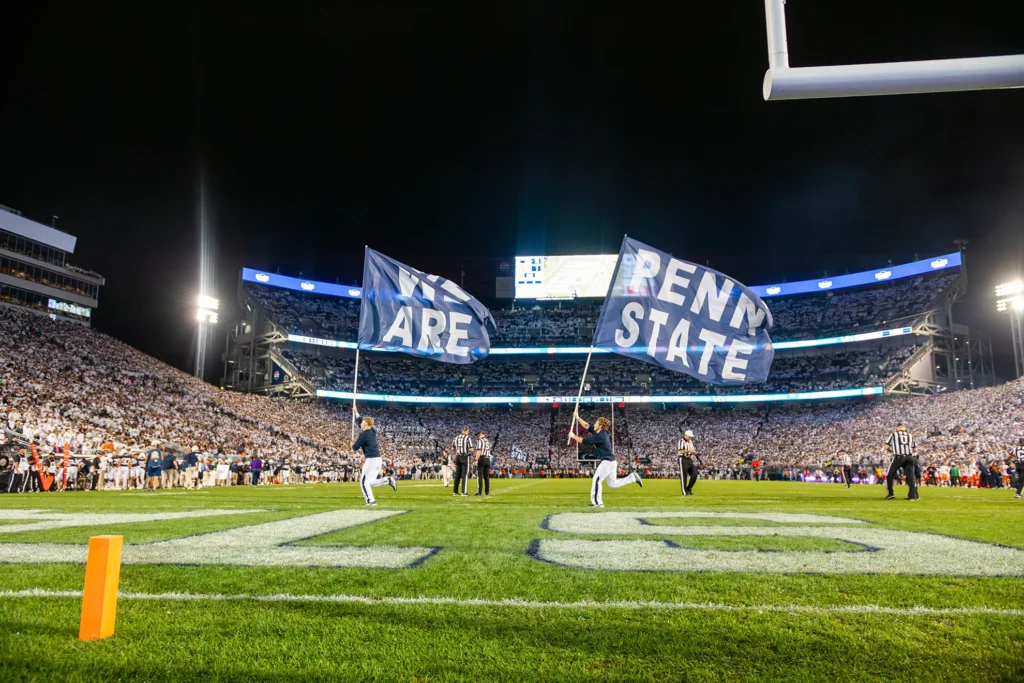
Can something be spectacular and so-so at the same time?
Yep, and especially if that something is Beaver Stadium.
As Penn State prepares to wind down a string of four consecutive home games at the world’s fourth-largest stadium Saturday against UCLA, there are parts of the Beaver Stadium experience that feel like they might not be much different from what they were when the Bruins last visited Happy Valley in 1967.
Heck, there are portions of the stadium that are the same as they were back then, when it seated just 46,000 people a few years after it was moved in hundreds of pieces from the west side of campus, which happened in 1960. Some of the steel roots of the stadium, part of the lower bowl, date to 1936.
At the same time, there are also some parts of the experience that feel state of the art, clearly worthy of 2024 and beyond. Some self-service kiosks for food, opportunities for high-end fans to watch the team enter the field from the Tunnel Club and fireworks, of course fireworks, for big moments and especially big night games.
There’s more to come as the stadium’s upcoming construction project, with its $700-million-plus price tag, moves forward. Plus, fans reliably show up. An average of 107,766 fans have attended this season’s first three home games, and they must enjoy the experience, or they would not be there.
In many ways the stadium is a conundrum — so big and at the same time so small, with some neighboring fans who’ve known each other and shared routines for years, even generations. It’s this behemoth, a huge erector set located on the campus in a comparatively small college town.
Plus, the experiences of fans on the east, west, north and south parts of the stadium can differ greatly. They’re in full voice as one group of #107k but their gamedays differ by access routes to their seats, amenities near them and how they hear and see the game itself.
Certain things have worked well at the stadium for years, but changes in the sports industry, and changes in fans’ expectations, have bumped up the need to do some things differently.
On the one hand, Penn State athletic director Patrick Kraft has repeatedly cited an example of rust falling into people’s food as a reason for recent and upcoming changes. That’s true, although any complaints about that rust never hit media outlets. Maybe folks just reported their concerns to the athletic department.
At the same time, the coming changes are not so much about Joe and Jane Fan as they are about attracting big events — and more well-to-do fans willing to pay for premium amenities and seating for more than just seven football games each fall.
Renovations and updates leading into this season addressed some access and egress issues, improved gates and entrance areas, provided more escalators, created some wider concourses and even added some additional food and beverage options. In addition, field level and top-of-stadium ribbon boards have been added, and videoboards have been updated.
It’s eye-catching stuff, as well as practical stuff, with more to come.
Even with all that, the sound system remains less than worthy of the second-largest stadium in college football, and the gameday presentation annually follows a reliable path that moves from practice mode to improvement as the season moves along. Things almost always seem better midway through the season, as those producing things hit their stride.
It can be both frustrating or funny depending on your expectations or you point of view.
At times, it all seems spectacular. At others, it’s just so-so.
Beaver Stadium can be an emotion-filled community gathering place — rocking and special, awash in white and with rich traditions on display. It can also be congested and cramped, home of an unfocused presentation of the game itself and not all that fan friendly.
Some improvements for this season seem so practical and simple, like adding porta potties on the wider concourses to better serve fans. Plus, there have been branding changes throughout the stadium, maybe not significantly upgrading foods as concession stands but seemingly giving many of those stands more distinctive names to connect to Penn State history and traditions.
Self-checkout options at some food areas offer efficiency and the implementation of an approach that works at places all over the country, and world.
The stadium has a well-earned reputation for its energy. That’s in large part thanks to the emotions fans bring, and especially the annual White Out. And that’s a significant change from the 1970s to 1990s, when Beaver Stadium was often known for how passive and quiet its fans were.
So, significant change can happen at Beaver Stadium. It’s happened before.
If all that’s coming can consistently help move the place toward spectacular and away from so-so, that would be a big success.
If you’ve enjoyed this content, please subscribe to Stuff Somers Says With Steve on YouTube. Or join our newsletter by entering your email below.

